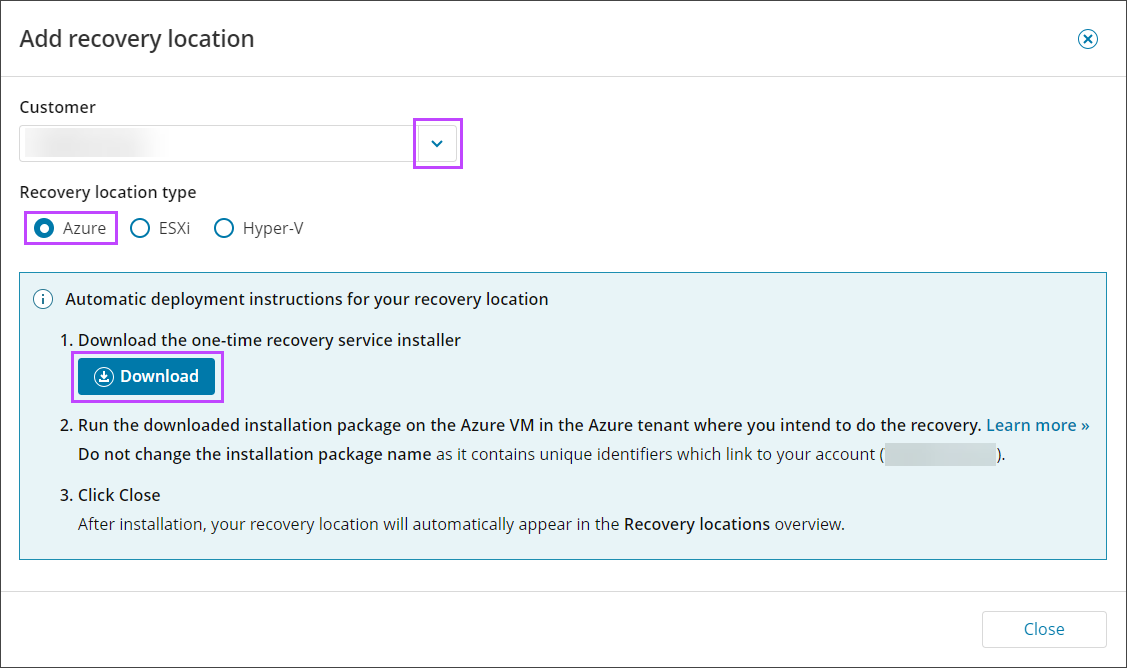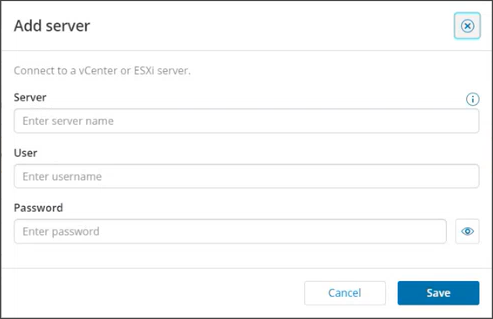Instructions for how to Configure N-able Recovery Service on Azure Recovery Locations must be followed specifically, due to several differences in the Azure configuration.
Instructions for how to Configure N-able Recovery Service on ESXi Host Server must followed specifically, due to several differences in the ESXi server configuration.
Instructions for how to Configure N-able Recovery Service on Hyper-V Server 2019 must be followed specifically, due to several differences in the Hyper-V 2019 server configuration.
Create Recovery Locations
Azure
- Sign in to the Management Console using a SuperUser account.
- Navigate to Continuity > Recovery Locations
- Click Add recovery location at the top of the page
- In the Add Recovery Location wizard, select the customer to attribute the recovery location to, from the dropdown
- Select Azure as the Recovery Location Type
- Download the recovery service installer and save it to an easily found place on your device
Do not change the installation package name. The installation package name contains unique identifiers to your account.
This is a one-time installer and can only be used to install a single instance of the recover service. The installer will fail if you attempt to use the same package for another installation.
- Continue following the instructions on how to Create the Recovery Location VM
- Then Installing and Configuring the Recovery Location on the Azure VM
- Followed by Assigning Permissions to the Recovery Location VM
Only once location VMs are created, installed, configured and all permissions given, can you begin the One-Time Restore or Standby Image to Azure.
ESXi
- Sign in to the Management Console using a SuperUser account.
- Navigate to Continuity > Recovery Locations
- Click Add recovery location at the top of the page
- In the Add Recovery Location wizard, select the customer to attribute the recovery location to from the dropdown
- Select ESXi as the recovery location type
- Download the recovery service installer
Do not change the installation package name. The installation package name contains unique identifiers to your account.
This is a one-time installer and can only be used to install a single instance of the recovery service. The installer will fail if you attempt to use the same package for another installation.
- Run the downloaded installation package on the Virtual Machine as created in Step 3: Create Recovery Location Virtual Machine
The recovery location will appear in the list after installation is complete
Add Storage Location and Server Connections
- Sign in to the Management Console using a SuperUser account.
- Navigate to Continuity > Recovery Locations
- Find the new recovery location in the list and click Add storage location
- Provide local file path for the storage location
- Local Drive:
Without a storage location, connections cannot be made to any of the added servers. If you want to restore to Local VMDK is not obligatory to configure server connections. The VMDK file will be restored directly to the storage path, and not on the ESXi server.
- Network Share:
Recovery Locations using Network Shares will not see the option to configure any server connections as the restore will not be done on an ESXi server, and will be done on the Network Share to a Local VMDK restore format.
- Local Drive:
- Click Add Connection to connect to the vCenter or ESXi server
If using a connection to the vCenter server, you will be able to restore to any ESXi host connected to the vCenter server
- Enter the vCenter or ESXi server name or IP address, and your username and password for this
- Click Save
Multiple server connections can be added to the recovery location, but must be done one at a time. Doing so will allow you to connect and restore to several ESXi hosts which are not connected to one vCenter Server
You must click the refresh button to above the list of server connections to update the status from 'connecting' to 'connected'. The connection may take a few minutes.
Once locations are added, you may continue with adding devices to the Standby Image plan.
Installing the Recovery Locations recovery service on an ESXi Host server requires additional configuration during the setup of the environment. See here for instructions on configuration of the recovery service on ESXi Host Servers.
Hyper-V
- Sign in to the Management Console using a SuperUser account.
- Navigate to Continuity > Recovery Locations
- Click Add recovery location at the top of the page
- In the Add Recovery Location wizard, select the customer to attribute the recovery location to from the dropdown
- Select Hyper-V as the recovery location type
- Download the recovery service installer
- Run the downloaded installation package on the device where the Virtual Machines should be restored to
- Give the recovery location a storage location by:
- Click Add storage location
- Enter the drive letter or local path to the folder where your virtual machine files will be stored in the box
- Click Save
Do not change the installation package name. The installation package name contains unique identifiers to your account.
This is a one-time installer and can only be used to install a single instance of the recovery service. The installer will fail if you attempt to use the same package for another installation.
The recovery location will appear in the list after installation is complete
Once locations are added, you may continue with adding devices to the Standby Image plan.
Installing the Recovery Locations recovery service on a Hyper-V Server 2019 requires additional configuration during the setup of the Hyper-V. See here for instructions on configuration of the recovery service on Hyper-V Server 2019.








